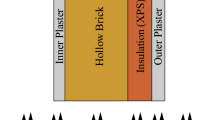Abstract
The whole (or holistic) building design approach is important for sustainability and fire safety. It is, however, challenging to design a building holistically due to it requiring a designer to take into account various design factors and their effects on multiple performances. It is very difficult to do such a design without a proper design tool. This study proposes a performance-based, multi-characteristic optimization tool for a wall-insulation system. The wall-insulation system of a building has multiple performance objectives, such as energy-saving, fire safety, soundproofing, sustainability, and cost. The tool quantifies the performance values of the five objectives and identifies the best combination of sheathing layers and insulation materials based on the quantified performance value. This tool also addresses an issue of the current insulation system design approach in the building code, by proposing a performance-based design approach for a thermal barrier design. The tool is expected to assist architects or building designers in comparing various wall-insulation systems.












Similar content being viewed by others
References
Whole Building Design|WBDG (2021) Whole building design guide. https://www.wbdg.org/resources/whole-building-design. Accessed 15 April 2021
Gritzo LA, Senseny PE, Xin Y, Russell Thomas J (2005) The international FORUM of fire research directors: a position paper on verification and validation of numerical fire models. Fire Saf J 40(5):485–490. https://doi.org/10.1016/j.firesaf.2005.02.001
Hidalgo-Medina JP (2015) Performance-based methodology for the fire safe design of insulation materials in energy efficient buildings. https://era.ed.ac.uk/handle/1842/10601. Accessed 15 April 2021
Roberts BC, Webber ME, Ezekoye OA (2015) Development of a multi-objective optimization tool for selecting thermal insulation materials in sustainable designs. Energy Build 105:358–367. https://doi.org/10.1016/j.enbuild.2015.07.063
ASTM E05 Committee (2021) Test method for surface burning characteristics of building materials. ASTM Int.https://doi.org/10.1520/E0084-21
UL (2018) Test for surface burning characteristics of building materials. UL LLC
Walker R, Pavía S (2015) Thermal performance of a selection of insulation materials suitable for historic buildings. Build Environ 94:155–165. https://doi.org/10.1016/j.buildenv.2015.07.033
Reid E (1988) Understanding buildings: a multidisciplinary approach. The MIT Press, Cambridge
Maldovan M (2013) Sound and heat revolutions in phononics. Nature 503:7475. https://doi.org/10.1038/nature12608
You Y-G (2018) Development of a performance based (multi-characteristic) tool for wall insulation system optimization. Worcester Polytechnic Institute, Worcester
The United Nations (2021) The world commission on environment and development: our common future. The United Nations. http://www.environmentandsociety.org/mml/un-world-commission-environment-and-development-ed-report-world-commission-environment-and. Accessed 5 May 2021
Annual Energy Review (2007) Energy information administration. https://www.osti.gov/servlets/purl/1212314. Accessed Jun 2021
Energy Information Administration (2008) Emissions of Greenhouse Gases in the United States 2007. Energy Information Administration, DOE/EIA-0573(2007)
Gypsum Association (2022) Environmental product declaration-typical (5/8" type X) North American gypsum boards. Gypsum Association. https://www.usg.com/content/dam/USG_Marketing_Communications/united_states/product_promotional_materials/finished_assets/type-x-wallboard-epd-en.pdf
Hidalgo JP, Welch S, Torero JL (2015) Performance criteria for the fire safe use of thermal insulation in buildings. Constr Build Mater 100:285–297. https://doi.org/10.1016/j.conbuildmat.2015.10.014
NFPA (2022) Standard method of fire tests for the evaluation of thermal barriers. National Fire Protection Association
ASTM (2020) Standard test methods for fire tests of building construction and materials. ASTM Int
UL (2011) Fire tests of building construction and materials. UL LLC
Babrauskas V, Lucas D, Eisenberg D, Singla V, Dedeo M, Blum A (2012) Flame retardants in building insulation: a case for re-evaluating building codes. Build Res Inf 40(6):738–755. https://doi.org/10.1080/09613218.2012.744533
FM Global (2023) Foamed polystyrene for construction. (Data Sheet 1–58). FM Global, Norwood
Kerber S (2012) Analysis of changing residential fire dynamics and its implications on firefighter operational timeframes. Fire Technol 48(4):865–891. https://doi.org/10.1007/s10694-011-0249-2
Hurley MJ et al (eds) (2015) SFPE handbook of fire protection engineering, 5th edn. Springer, New York
Window Types: BASIX (Building Sustainability Index) (2021) https://www.basix.nsw.gov.au/iframe/198-archived-help-notes/521-window-types.html. Accessed 24 May 2021
European Committee for Standardisation. (2002) EN 1991-1-2: eurocode 1: actions on structures: part 1–2: general actions: actions on structures exposed to fire. http://archive.org/details/en.1991.1.2.2002. Accessed 24 May 2021
Magnusson SE, Thelandersson S (1970) Temperature–time curves of complete process of fire development. https://portal.research.lu.se/portal/en/publications/temperature--time-curves-of-complete-process-of-fire-development(df6f4cf6-ad5f-4c65-9433-30df4708144d)/export.html. Accessed 18 April 2021
Puig JP (2008) Numerical modelling of sound transmission in lightweight structures. PhD Thesis, Universitat Politècnica de Catalunya (UPC)
Environmental Product Declaration-Plywood. Wood solutions. https://portal.environdec.com/api/api/v1/EPDLibrary/Files/cd0ad1c8-7fd0-4c68-b8f0-08d8d1855218/Data. Accessed Oct 2021
Mont O (2007) Ecological economics research trends. Ecol Econ Res Trends 1:13–44
OECD glossary of statistical terms: carbon dioxide equivalent definition.https://stats.oecd.org/glossary/detail.asp?ID=285. Accessed 19 April 2021
Plotner SC (2014) RSMeans building construction cost data, 73rd edn. RS Means, London
Keeney RL (1982) Feature article—decision analysis: an overview. Oper Res 30(5):803–838. https://doi.org/10.1287/opre.30.5.803
Watts J (1997) Fire risk assessment using multiattribute evaluation. Fire Saf Sci 5:679–690. https://doi.org/10.3801/IAFSS.FSS.5-679
Saaty RW (1987) The analytic hierarchy process—what it is and how it is used. Math Model 9(3):161–176. https://doi.org/10.1016/0270-0255(87)90473-8
Incropera FP, DeWitt DP, Bergman TL, Lavine AS (2006) Fundamentals of heat and mass transfer, 6th edn. Wiley, Hoboken
PanelGuide: wood panel industries federation. https://wpif.org.uk/PanelGuide. Accessed 19 April 2021
Marsh D (2008) WRAP: comprehensive life-cycle analysis of plasterboard. Global Gypsum Magazine. https://portal.ct.gov/-/media/DEEP/waste_management_and_disposal/Solid_Waste_Management_Plan/GypsumWallboard/Jan2010/WRAPComprehensivelifecycleanalysisofplasterboardMay2008pdf.pdf
Home at Menards®. https://www.menards.com/main/home.html. Accessed 22 April 2021
Forensic TC (2021) Article 10: physical constants for investigators.https://www.tcforensic.com.au/docs/article10.html. Accessed 24 May 2021
Minnesota sustainable housing initiative. http://www.mnshi.umn.edu/kb/scale/insulation_densepack.html. Accessed 19 April 2021
Open-cell vs. closed-cell polyurethane spray foam insulation. http://www.energyefficientsolutions.com/open-cell-vs-closed-cell.asp. Accessed 19 April 2021
National Centers for Environmental Information (NCEI). https://www.ncei.noaa.gov/. Accessed 19 April 2021
Builder Practices Report 2011 (2012) NAHB Research Center, Inc
Wieczorek CJ, Ditch B, Bill RG (2010) Environmental impact of automatic fire sprinklers. FM Global, technical report. https://www.fmglobal.com/~/media/Files/FMGlobal/Research%20Technical%20Reports/p10062.pdf
Author information
Authors and Affiliations
Corresponding author
Ethics declarations
Conflict of interest
The authors declare that they have no competing interests.
Additional information
Publisher's note
Springer Nature remains neutral with regard to jurisdictional claims in published maps and institutional affiliations.
Rights and permissions
Springer Nature or its licensor (e.g. a society or other partner) holds exclusive rights to this article under a publishing agreement with the author(s) or other rightsholder(s); author self-archiving of the accepted manuscript version of this article is solely governed by the terms of such publishing agreement and applicable law.
About this article
Cite this article
You, YG., Park, H. & Dembsey, N.A. Development of an Optimization Tool for Wall-Insulation Systems with a Focus on Fire Safety. Fire Technol (2023). https://doi.org/10.1007/s10694-023-01479-4
Received:
Accepted:
Published:
DOI: https://doi.org/10.1007/s10694-023-01479-4




